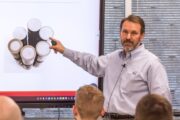April 27 - 30th, 2026 M 1-6pm, Tu-Th 8am-4pm, All times CST Fundamentals of Threaded Fasteners and Joint Design
Course Overview
This comprehensive course, completed over 3.5 days, provides engineers, designers, and technical professionals with foundational knowledge and practical tools to understand, specify, assemble, and troubleshoot threaded fasteners and bolted joints. Designed with a strong emphasis on failure prevention and real-world application, the course blends fundamental engineering principles with hands-on demonstrations and team-based problem-solving.
Note: The focus of the course will be on dynamically loaded fastened joints rather than structural joints according to AISC 360. Although the VDI-2230 standard will often be referenced, the course is not intended to provide a detailed presentation of this standard.
Course Instructors

Jon Ness
PE, PMP, NPDPJon is a Managing Governor and Principal Engineer at Matrix Engineering and has over 34 years of experience in business and engineering team leadership. His career has been focused on the development of off-highway equipment and powertrains. He has unique technical expertise in designing and validating dynamically loaded bolted joints. In his consulting role, Jon has led numerous joint failure investigations, including re-design efforts to mitigate risks to the system owners. He actively participates in ongoing research projects and has taught many classes related to Failure Modes and Effects Analysis and Bolted Joint Design and Validation. He received a Bachelor of Science in mechanical engineering from South Dakota State University. A licensed engineer in Minnesota, Jon is an active member of the UL2703 Standards Technical Panel, a contributor to the ASCE Manual of Practice for Solar PV Structures, and a Certified Fastener Specialist through the Fastener Training Institute.

Laurence Claus
Mr. Claus has over 35 years in the fastener industry. He spent the first 26 years with a fastener manufacturer, becoming an expert in threaded fasteners, especially those in the automotive and aerospace market segments. For the last 10 years, he has served the industry as both trainer and consultant, as the President of his company, NNi Training and Consulting Inc., and as the Industrial Fastener Institute’s Director of Training and Education. Additionally, Mr. Claus is the current Chairman of the SAE Fastener Committee, Vice Chairman of the ASTM Fastener Committee F16, Subcommittee Chairman of ASME B18.6 of the ASME Fastener Committee B18, and Subcommittee Chairman of ASTM F16.91 of ASTM Fastener Committee F16. For this course, Mr. Claus will share his expertise in topics such as the fundamentals of threads, fundamentals of bolts, screws, and nuts, fastener materials, metallurgy, and heat treatment, making sense of the various bolt strength classes, and fastener platings and coatings.